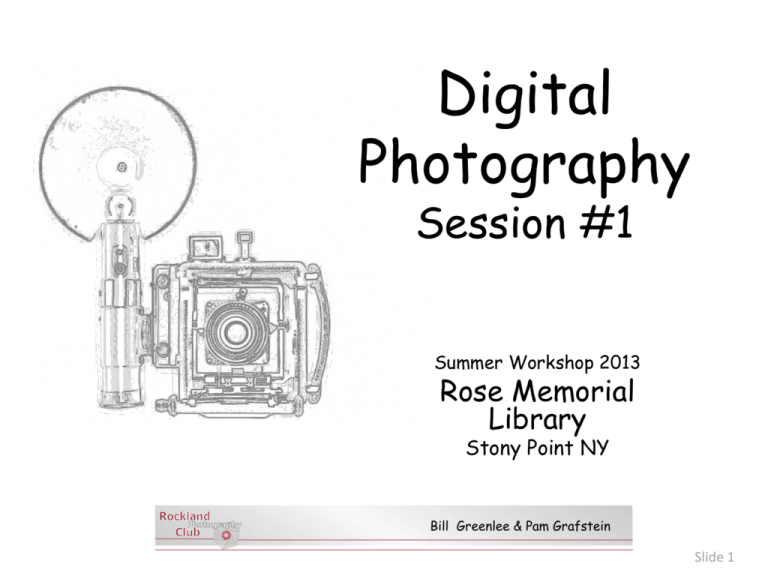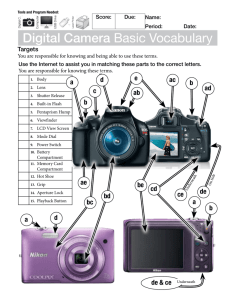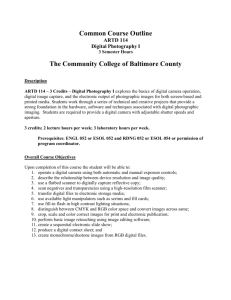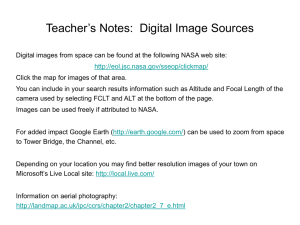Image: Wikipedia - Rockland Photography Club
advertisement

Digital Photography Session #1 Summer Workshop 2013 Rose Memorial Library Stony Point NY Bill Greenlee & Pam Grafstein Slide 1 Agenda Session #1 • • • • • • • • • • • • Introductions Informal Audience Poll - Interests and Experience Why Shoot Digital ? Most Common Motivations Types of Digital Cameras Typical Workflow – Scene -> Camera ->PC -> Final Output Common Photographic terms Break (10 min) Image Transfer Demonstration Basic Image Editing (PC Software & Projector) Common Image Formats & Applications Elements of a High Quality Image Handouts &Homework Assignment for Session #2 – – – • What is a Histogram? Elements of a Good Photographic Image Elements of a Good Competition Image Q& A Session Slide 2 Audience Interests • Informal Poll –Interests and Experience – How Many: – – – – – – – Own A Digital Camera? Have Read the Manual Recently? What experience level? None? Beginner? Intermed? Advanced? Can Use Its Basic Functions? Know How to Transfer Images to Local PC or Website? Have Printed Their Own Images? Have Used Image Processing Software? • Why Shoot Digital ? Most Common Motivations/Advantages – – – – – Much Wider Availability to Consumers & Pros (Film Now a Niche/Commercial Market) Simpler Than Film (No More - Rolls of Celluloid, Chemicals, Darkroom, Opening Camera in Dark Space) Quicker/Easier Review and Sharing (Local Display, Electronic File Sharing) Less Physical Storage Space Required (Memory Card holds 100’s or 1000’s of Images) Greater Control Before the Shot (Depending on Camera Features) Slide 3 Types of Digital Cameras Images: Amazon.com Mobile Devices Compact ($79) “Point n’ Shoot” ($349) Entry Level DSLR ($355) “Prosumer” DSLR ($1497) Professional DSLR ($5999) Professional DSLR High End/Specialty ($17,995) Types of Digital Cameras Feature DSLR Compact Interchangeable Lenses X Full Range of Auto/SemiAuto/Manual Settings X Thru the Lens Viewfinder X True Shutter Action X Remote Shutter Activation (Cord & Wireless) X Still and Video X X Flash: Built-In X X Flash: “Hot Shoe” X Shutter Delay (After Pushing Button) USB Cable Image Download Focal Plane Area Fast Slow-to-Med X X Med or Large Small Slide 5 Common Digital Photography Terms Exposure Common Digital Photography Terms DSLR Digital Single Lens Reflex (DSLR) – type of camera that relies on a retractable mirror system allowing thru the lens composing and metering and moves the mirror out of the optical path when shutter is released. Focal Length Focal Length - distance from the center of the first lens element to the focal plane of the lens (Actually Effective Focal Length) Common Digital Photography Terms DSLR Image: Wikipedia Focal Plane Location Mark Focal Length Common Digital Photography Terms Compact Camera Focal Plane Exposure Setting (1/1000 Sec) Out (Electronic Shutter) Image: Wikipedia JM (Electro-Mechanical Shutter) (Shutter Open Duration in Seconds) <- Dim Scenes/Low Light Shutter Release Button Bright Scenes/Strong Light-> Common Digital Photography Terms Shutter Release Button Smaller Hole (Less light) Bigger F Number = And Greater Depth of Field Aperture Setting (F 8) F- Number = Focal Length Aperture Dia JM Image: Wikipedia Common Digital Photography Terms Image: Wikipedia Small Aperture = Large DoF Large Aperture = Shallow DoF Image: Wikipedia Common Digital Photography Terms Think of ISO as Focal Plane (Sensor) Sensitivity to Light Camera ISO Setting Image Signal + Readout Noise To Memory Card & Camera Display Low Amp Gain Med Hi ISO Button Gain X (Image Signal + Readout Noise + Amp Noise) Camera Focal Plane (Sensor) (After Shot) Image: Wikipedia ISO 400 Common ISO Values 100 ISO 6400 200 400 800 1600 3200 6400 ISO Setting (400) Common Digital Photography Terms Common Digital Photography Terms • • • • • A Feature of Many Types of Digital Cameras Unique for Each Image Useful for Immediate Evaluation Intensity (Tonal) Range Can be Manipulated in Processing Software More Practical Details in Session #2 Image: Wikipedia Intensity Value 0 128 255 Think of the Histogram as a “census” of the light intensity (0-255) captured by each pixel in the focal plane Common Digital Photography Terms Zoom Optical vs Digital Optical Zoom –variable magnification controlled by moving lens elements Digital Zoom – variable magnification by electronically undersampling (cropping) image on focal plane Macro Lens Closeup lens capable of producing image size (on focal plane) equal to subject size (1:1) Telephoto Lens Long-focus lens in which the physical length of the lens is shorter than the focal length Break Image Transfer Demonstration Typical Workflow USB OR USB or Wireless CD Storage Plan Shot Shoot Download Disk Storage Process/Archive Display/Share Basic Image Editing (PC) •Common Image Editing Software • • • • • • Elements (Adobe) Light Room (Adobe ) Photoshop CS (Adobe) Picasa (Google) MS Office (Microsoft) “In-the-Box” Applications •Common Editing Tasks Resources: http://picasa.google.com/ •Cropping •Rotation •Red Eye Removal •File Conversion •File Sizing •Creative Effects (Frames, B&W Conversion, Contrast, Saturation, etc) Common Image Formats For Photographers JPEG (*.jpg) – Joint Photographic Experts Group Most common format, 8-bit grayscale/24-bit color, lossy compression Smallest file size (w/full compression), web friendly RAW (?) - Not an industry standard, variations among camera vendors Unique software required, not web friendly, lossy or nearly lossless Greatest advantage: post-processing flexibility w/PhotoShop, Lightroom apps Examples: Nikon: *.nef Canon: *.cr2 TIFF (*.tif)- Tagged Image File Format Commercial applications 24-bit/48-bit, lossy or lossless compression Largest file size (w/lowest compression), not web friendly GIF (*gif) -Graphics Interchange Format Web and graphic arts applications , 8-bit color only. Medium file size Most useful for drawings diagrams poster art simple animations, web friendly BMP (*.bmp) - Windows Bitmap Graphics files within the Microsoft Windows. Simplicity and wide acceptance in MS Windows applications. No compression, large file size Elements of a High Quality Image Impact – Initial reaction, emotional response Creativity – Obvious contribution of maker to image message/thought Style – “Signature” elements of image characteristic of maker’s vision Composition – Placement and relationship of visual elements in image Presentation – Vehicle or environment chosen to display image Center of Interest – Point or points in image which attract viewer’s eye Lighting – Maker’s use of natural or artificial to enhance image Subject Matter – Foundation for the visual story being told Color Balance – Harmony of color/tonality to effectively support image Technical Excellence – Maker’s skill/knowledge of equipment, environment Technique – Collective approach creating the final image Story Telling – Ability to strongly evoke viewer’s imagination or association Handouts & Homework Assignment Practical Exercises - preparation for Night 2 (choose 1 or more ) Bring in favorite image for a basic critique according to principles of a good photographic image (.jpg on memory stick + print) Bring two .jpg images of identical composition/subject, one with flash, one without as examples for Night 2 discussion of the role of flash vs ambient light (.jpg’s on memory stick + prints) Will discuss/critique on Night 2 as time permits Handouts: 1) 12 Elements of an Outstanding Image 2) What’s a Competition Image? 3) What is a histogram? Q & A Session What’s on Your Mind? Resources Rockland Photography Club (NY) http://www.rocklandphotoclub.org/ Meets Sep-May first and third Thursdays of the month at 7:00 pm in the Clarkstown Community Center in New City, 31 Zukor Road, New City, NY 10956-4301. Picasa (Google) http://picasa.google.com/ Archive, edit, share personal images. Free download. User’s guide available at: https://support.google.com/picasa/answer/1753765?ref_topic=1751920&rd=1 The Luminous Landscape http://www.luminous-landscape.com/index.shtml High quality learning site for landscape, nature and general image processing info Photographic Society of America (PSA) http://www.psa-photo.org/index.php?home Provides education, information, inspiration and opportunity to all persons interested in photography; fosters personal growth and expression, creativity, excellence and ethical conduct in all aspects of photographic endeavor Credits • Graphics and Text Not Credited – Bill Greenlee RPC – Pam Grafstein RPC – Microsoft Clip Art (Public Domain) • Other Graphics Marked as – Jay Matusow/”Photo Aspirations 2013” – Wikipedia.com Image: Wikipedia – Amazon.com Image: Amazon.com JM Contact Information Date________ Your Name Email Phone Your Interest Element (Discussion Example) Impact Back Element (Discussion Example) Creativity Back Element (Discussion Example) Style Back Element (Discussion Example) Composition Back Element (Discussion Example) Center of Interest Back Element (Discussion Example) Lighting Back Element (Discussion Example) Color Balance Back Element (Discussion Example) Technical Excellence Back Element (Discussion Example) Technique Back Element (Discussion Example) Story Telling Back







